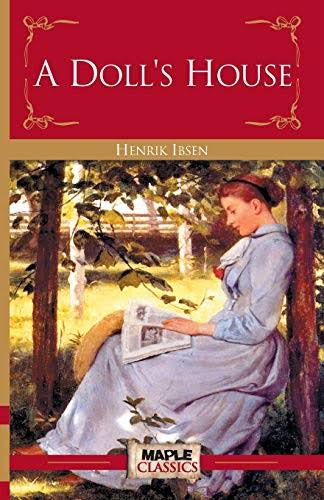🎉 Holiday Promo! Get Study Guides for 10+ WASSCE Texts — Just ₦5,000 (July 27 – Sept 18)
Author’s Biography
Henrik Ibsen was born in 1828 in Skien, Norway. He was the oldest of five children after his older brother passed away.
His father, Knud Ibsen, was a sea captain born in Skien in 1797. Knud married Marichen Cornelia Martie Altenburg, the daughter of a German merchant, in 1825.
Ibsen had to leave school at fifteen (15) years old. He moved to Grimstad and started writing seriously. Inspired by the revolutions of 1848, Ibsen wrote satire and elegant poetry. In Christiana, he wrote his first play, Catiline, in 1849. It was a blank verse play about the failed conspiracy of Catiline against ancient Rome during the time of Cicero. The play only sold 45 copies and was rejected by every theatre that Ibsen submitted it to.

Ibsen also spent time analyzing and criticizing Modern Norwegian literature. Ibsen got married to Suzannah Thoreson, and they had a child named Sigurd Ibsen.
In 1879, in Munich, Ibsen wrote his groundbreaking play, A Doll’s House. He continued to focus on realistic drama for the next ten years, earning international acclaim.
Many of his works were published in different languages and performed across Europe. His last works were Hedda Gabler in 1890 and The Master Builder in 1892, both completed while he was abroad.
Ibsen is often called the “Father of Realism” and one of the most influential playwrights of his time. As one of the founders of Modernism in theater, he made significant contributions. He passed away on May 23, 1906, at the age of 78, after experiencing several strokes.
Background of the Play
Ibsen’s A Doll’s House (1879) was written while Ibsen was in Rome and Amalfi, Italy, during a time of revolution in Europe. It was published in Copenhagen, Denmark, where it premiered.
Its success was particularly important for Norway and the Norwegian language. Norway had recently gained independence from Danish rule in 1814, and was still in the process of shaking off the influence of Danish domination.
It is believed that the plot of A Doll’s House was inspired by an event in Ibsen’s life in 1870. A woman named Laura Kieler had sent Ibsen a sequel to his play Brand, called Brand’s Daughters. Ibsen became interested in Laura and even gave her the nickname “The Lark”. She visited his home regularly for two months during the summer of 1872.
A few years later, Laura got married. However, her husband became ill and was advised to take a vacation in a warm climate. Like Nora, the main character in the play, Laura secretly borrowed money to finance the trip, which took place in 1876. Laura falsified a note, but the bank refused payment, and she confessed everything to her husband. He demanded a separation and took away their children. Laura was only allowed to return home after spending a month in a public asylum.
While Laura and Nora have similar-sounding names, their stories diverge. In Ibsen’s play, Nora never goes back home, nor does she tell her husband about her decision. Most importantly, it is Nora who initiates the divorce from her husband.
Structure of the Play
Before the play begins, all the important events in the lives of Ibsen’s characters have already happened, and it is the play’s purpose to deal with the consequences of these past actions.
Ibsen demonstrates how each character’s actions are influenced by their previous circumstances.
For example, the author shows that Nora’s impulsiveness and careless handling of money are traits she inherited from her father. Krogstad suddenly becomes an honest man in order to leave a good reputation behind. Christine comes back to town to rekindle her relationship with Krogstad.
Lastly, to explain why Nora keeps her borrowing money a secret, Ibsen shows how Torvald’s life revolves around maintaining appearances, even if it means sacrificing the truth.
Age of the Text
A Doll’s House was written during a period in Norway when married women had few chances to pursue their own happiness in a society controlled by men. It challenged the traditional gender roles of that era, which led to a lot of debate and disagreement.

Plot Analysis
When the play opens up, the exposition shows it is Christmas Eve, and we find out that Torvald had just been promoted to be the manager of the bank where he works, where he will start receiving huge wages and being in a position of power. Nora is really thrilled about this as it opens a big opportunity for her to be able to spend as she wishes and stop having to manage as it used to be.
Her friend, Mrs. Linde visits and both discuss at full length, with Mrs. Linde telling Nora of her woes and belittling Nora of knowing so little about the cares of the world.
Nora is then forced to reveal the secret of how she had to borrow money from a man named Krogstad by forging her father’s signature to be able to pay for a trip to Italy to save her sick husband’s life (her husband was unaware of the loan, believing the money came from Nora’s father). Mrs. Linde asks for a job at Torvald’s bank and is offered one.
The rising action begins when an angry Krogstad approaches Nora, having learned that his position at the bank has been promised to Mrs. Linde and promised to reveal Nora’s secrets if she does not persuade her husband, Torvald to let him keep his position. Nora tries all her best to convince Torvald not to sack Krogstad which she is unsuccessful at. Torvald is not comfortable with Krogstad’s ill repute and remains adamant on sacking him.
The next day, Nora becomes so nervous, afraid Krogstad would appear any minute to reveal the secret. When Torvald returns from work, she again pleads with him on behalf of Krogstad. This time, Torvald not only refuses, but also sent off the sack letter he has prepared for Krogstad, reassuring Nora he would bear the consequences that arise from his action.
Meanwhile, Nora converses with the family’s friend Dr. Rank, she learns he is rapidly dying and their conversation goes intimate as Dr. Rank professes his love for Nora just before he is able to ask for help. The confession stops her and she steers the conversation away from the help she was meaning to ask for.
Their talk is interrupted by the announcement of Krogstad’s presence in the house. Dr. Rank leaves and Krogstad comes in. Krogstad tells her, though he will not reveal her to the public, however, he would write Torvald a note explaining the matter to him so he would be able to revoke his sack decision. Nora protests against this.
The climax of the play comes in when Krogstad drops the letter containing Nora’s secrets in Torvald’s letter box, much to Nora’s horror. Nora tries all her best to prevent Torvald from reading the letter, thus, the letter remains in the letter box.
Mrs. Linde and Krogstad who are old lovers, re-unite in the Helmer’s living room, with Mrs. Linde reassuring Krogstad of her belief in him becoming a better man. The Helmers return as Mrs. Linde is leaving, Dr. Rank came to say his final farewell, as he covertly explains to Nora by sending a card with a black cross on it.
Torvald goes to collect his letter and Nora resigns to committing suicide. As she is leaving, Torvald stops her as he has just read Krogstad’s letter and he is enraged by its content. He accuses Nora of ruining his life, pride and ego. He tells her his plans of forsaking her and removing his children from her care.
During his rage, the falling action comes to play as he receives another note from Krogstad who has had a change of heart and resolves not to take anything or reveal any secret. Torvald quickly tells Nora all is now well and that he has forgiven her and that her action has only made her more endearing to him.
The resolution of the play comes in when Nora finally sees Torvald’s true character, she then sits her husband down and tell him she is leaving him, explaining that neither of them ever loved the other. Given the suffocating life she has led until now, she owes it to herself to be independent and explore the world for herself and that perhaps, one day, they might re-unite in real wedlock. The door slams on her way out as the play ends.
Setting
It is a play with three parts. The play was first performed at the Royal Theatre in Copenhagen, Denmark, on December 21, 1879. It was published during the time known as the Victorian era, which lasted from 1837 to 1901.
The mindset of the Helmer family in the play strongly reflects the values and beliefs of the Victorian era.
During this time, the Helmers belonged to the respectable upper-middle class. Although they were financially successful and stable, they still needed to work for a living. For instance, Torvald provided well for his family and they enjoyed social activities like balls and social visits, as well as having servants.
However, Torvald also advised Nora to spend wisely, as it was a common practice during the Victorian era.
Conclusion
A Doll’s House ends with the slamming of the door. Nora turns her back on her husband and kids. And takes off to make her own way to the world. It is a pretty bold decision, by making this choice, she is alienating herself from the society she has always been part of.
Nora makes the reason for her decision clear in her argument with Torvald. It seems that Nora has gone through a kind of personal awakening. She has finally realized she doesn’t know herself or the world from her perspective.
Nora is like the biblical Eve after she ate of the tree of knowledge, good and evil. All of a sudden, she is enlightened, but that enlightenment comes with a heavy cost.
But is there hope for Torvald and Nora getting back together? The ending of the play seems to suggest that maybe there is.
Read Also:
- Characterisation in Henrik Ibsen’s “A Doll’s House”
- Symbolism in Henrik Ibsen’s “A Doll’s House”
- Themes in Henrik Ibsen’s “A Doll’s House”
Receive Literary Updates through our Social Media Channels:
- WhatsApp: Literature PADI
- Telegram: Literature PADI
- YouTube: @literaturepadi
- Facebook: Literature PADI









